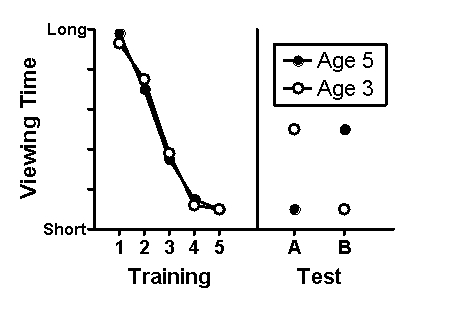Multiple Choice
Use the following to answer questions :
Scenario I
The scenario is based on and presents results consistent with the following study:
Kim,I.K. ,& Spelke,E.S.(1992) .Infants' sensitivity to effects of gravity on visual object motion.Journal of Experimental Psychology: Human Perception and Performance,18(2) ,385-393.
Kim and Spelke (1992) investigated the extent to which infants have expectancies of gravitational effects on visual object motion.Infants of 3 and 5 months of age repeatedly watched a video of a ball accelerating as it rolled down an incline until they spent little time actively looking at it.Subsequently,two types of test trials were conducted in randomized order.Type A test trials consisted of a ball slowing down as it rolled up an incline.Type B test trials consisted of a ball slowing down as it rolled down an incline.During all trials,the amount of time looking at each visual display was recorded.Fabricated data consistent with the major finding of this study are presented in Figure 11.1.
Figure 11.1  Note that "Age 5" and "Age 3" in the legend refer to months of age.
Note that "Age 5" and "Age 3" in the legend refer to months of age.
-(Scenario I) Which explanation is MOST likely for the decreased looking time across training trials?
A) Both groups of infants failed to acquire gravitational expectancies.
B) The video lost its novelty.
C) Both groups of infants acquired object permanence with respect to the ball.
D) The experimenters failed to arrange effective rewards for looking behaviour.
Correct Answer:

Verified
Correct Answer:
Verified
Q1: A teenage boy starts shaving because he
Q22: Once the principle of conservation is understood,children
Q24: About what percentage of adolescents identify themselves
Q91: Older adults show a much more pronounced
Q107: Infants learn to control their arms before
Q133: According to Erik Erikson's stages of psychosocial
Q188: An 18-month-old infant can recognize and imitate
Q189: During the embryonic stage,which event occurs?<br>A)An insulating
Q193: An infant in a visual perception experiment
Q210: Before deciding to have children,couples should understand